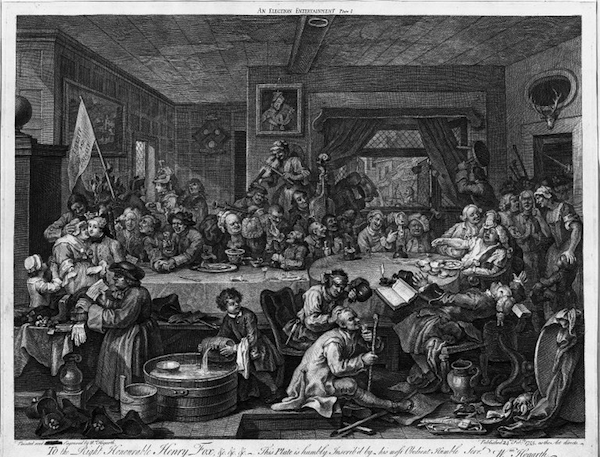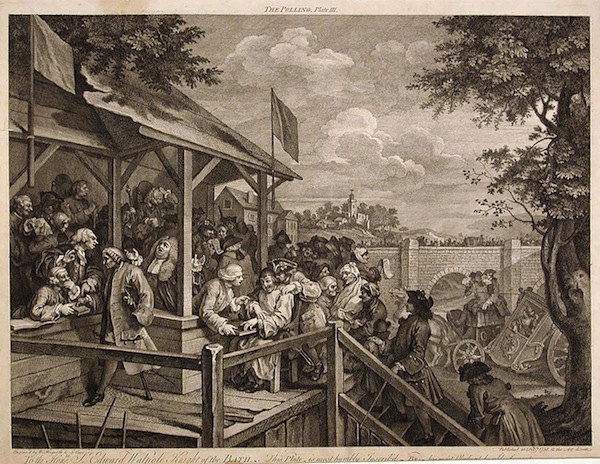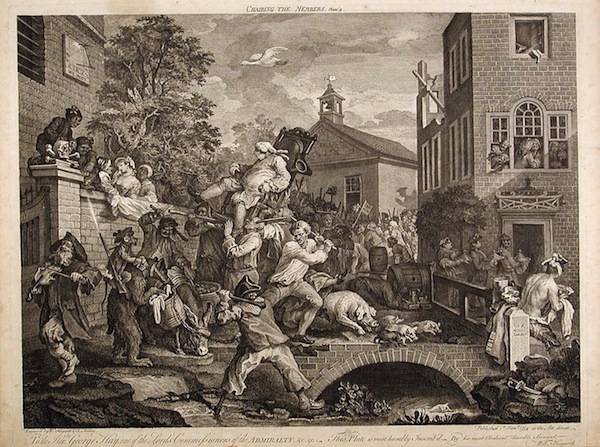William Hogarth’s Election series
After more than a year of partisanship, pundits, and polls, as well as a seemingly never-ending stream of gaffes, accusations, and distortions, Election Day has finally come and gone. Contemporary satirists had plenty to work with in this presidential campaign (see Barry Blitt’s most recent New Yorker magazine cover cartoon based on a Norman Rockwell painting from our collection), just as artists like James Gillray, Francisco Goya, and Honoré Daumier found inspiration in the politics of their own eras. Rich Aste, our Curator of European Art, reminded me that our print collection contains excellent works by these early giants of political satire, as well as by the artist that influenced all of them: William Hogarth (1697-1764).
Hogarth was an English painter and printmaker who took as his subject no less than the panorama of life in 18th-century London. From the drawing rooms of the aristocracy to the teeming and raucous city streets, Hogarth trained his critical eye on themes of marriage, adultery, prostitution, religion, disease, poverty, crime, drunkenness, insanity, gambling, commerce, and, of course, politics, creating indelible images that are spiked with humor and pathos, and brimming with narrative details.
For his four Election series prints (published in 1757-58 and based on his paintings dated 1754-55), Hogarth turned his attention from the squalor of urban life to the corruption of the political world. He was inspired by the notorious contest between the liberal Whig party and the conservative Tory party to win Oxfordshire’s parliamentary seats in the General Election of 1754. Set in the fictional country town of ‘Guzzledown,’ Hogarth depicts four stages of an election, each of which is filled with acts of bribery, mayhem, wastefulness, and venality; in short, a catalogue of behaviors and traits associated with winning by any means and at all costs.

William Hogarth (British, 1697-1764). An Election Entertainment from "Four Prints of an Election," 1755. Engraving on laid paper, 17 1/8 x 21 15/16 in. (43.5 x 55.8 cm). Brooklyn Museum, Bequest of Samuel E. Haslett, 22.1875 Image: overall, 22.1875_bw.jpg. Brooklyn Museum photograph.
The first scene, An Election Entertainment, presents a boisterous banquet organized by the Whig party in an attempt to wine and dine their way to victory. Deliberately parodying the composition of the Last Supper, Hogarth has squeezed his characters around two tables. The two candidates are seated next to each other at the left, one enduring a kiss from a toothless old woman and the other in the rough grip of two drunken men. At the right the local mayor has collapsed and is being bled after consuming too many oysters. Near him is an election agent who has been struck on the head by a brick thrown through the window by the Tory mob protesting outside.

William Hogarth (British, 1697-1764). Canvassing for Votes, from "Four Prints of an Election," 1755. Engraving Brooklyn Museum, Bequest of Samuel E. Haslett, 22.1890 Image: overall, 22.1890_bw.jpg. Photo Indianapolis Museum of Art.
In Canvassing for Votes, the second scene, the action takes place outside the Royal Oak inn, the Tory party headquarters. The inn’s sign has been partly covered by another sign that lampoons the Whig candidate, depicting him as the commedia dell’arte character Punch pushing a wheelbarrow full of coins he’s distributing to voters. Ironically, just beneath this sign stands the Tory candidate buying knick-knacks with which to bribe the girls flirting with him from the inn’s balcony, as well as a farmer being solicited simultaneously by political operatives from both parties.

William Hogarth (British, 1697-1764). The Polling from Four Print of an Election, 1758. Engraving on laid paper, 17 3/16 x 21 15/16 in. (43.7 x 55.8 cm). Brooklyn Museum, Bequest of Samuel E. Haslett, 22.1892. Photo Indianapolis Museum of Art.
The Polling is the third scene of the series and depicts the varied crowd of voters at the polling stand with the two candidates seated on chairs at the back of the platform beneath their party flags. Each side tries to extract votes from whomever they can, while disputing the other side’s right to do the same. The Tories try to get the vote of a seated man with clearly diminished mental faculties, the Whigs carry up a man in a white shroud who is either dying or already dead, and one of the parties’ lawyers appears to challenge a one-legged veteran’s right to swear his oath with the metal hook that has replaced his hand. In the background, a carriage emblazoned with Britannia’s flag topples over while the two coachmen obliviously play cards, further emphasizing the message that political negligence and mismanagement have imperiled the nation.

William Hogarth (British, 1697-1764). Chairing the Members from Four Prints of an Election, 1758. Engraving on laid paper, 17 3/16 x 21 7/8 in. (43.7 x 55.6 cm). Brooklyn Museum, Bequest of Samuel E. Haslett, 22.1891. Photo Indianapolis Museum of Art.
The theme of collapse continues in the riotous final scene, Chairing the Members, which shows the successful Tory candidates triumphantly carried through the streets. Led by a blind fiddler and surrounded by a chaotic crowd of people and animals, the central winner is about to fall as one of his bearers has been inadvertently hit in the head by another brawling supporter.
Although many of the allusions in the Election series prints presuppose an insider’s knowledge of the politics, procedures, and characters of the time, Hogarth’s witty and scathing take on the craziness that can surround the democratic process is timeless.

Lisa Small joined the Brooklyn Museum in Spring 2011 as Curator of Exhibitions. From 2007 until 2011 she was Curator of Exhibitions at the American Federation of Arts (AFA), coordinating traveling exhibitions such as Turner to Cézanne: Masterpieces from the Davies Collection, National Museum Wales, and Gods and Heroes: Masterpieces from the École des Beaux-Arts, Paris. Prior to joining the AFA, Small was a curator at the Dahesh Museum of Art, where she organized numerous exhibitions, including Napoleon on the Nile: Soldiers, Artists, and the Rediscovery of Egypt and Fantasy & Faith: The Art of Gustave Doré. Small has taught art history at Hunter College and Brooklyn College and has been a member of the art history faculty at the School of Visual Arts since 2008. Small earned a B.A. from Colgate University, an M.A. and an M.Phil in Art History from CUNY, and an M.A. in Arts Administration from NYU.
